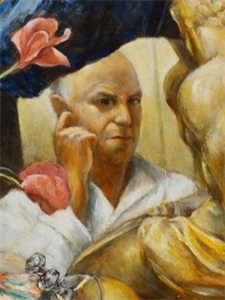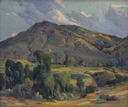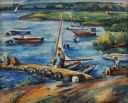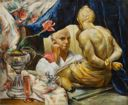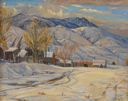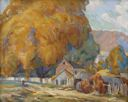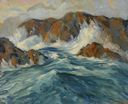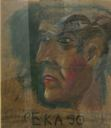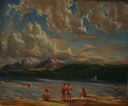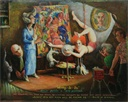David Howell Rosenbaum
(Brigham City, Utah, 1908 - 1983, Ogden, Utah)
The expressionist painter and Judeo-Mormon artist, Howell Rosenbaum, was one of Utah's great colorists. He began drawing and painting when he took a class in high school from Lura Redd. In his high school years, he purchased a Model T Ford. Often, Howell and his brother, Paul, traveled into the local canyons where Paul fished and Howell painted. Howell graduated from Box Elder High School in 1926. Rosenbaum's father and grandfather owned a successful mercantile business in Brigham City. Howell's father was not supportive of his son's desire to become an artist. He told Howell to get a "real job" because he could never make a living painting. Following his father's advice, Howell worked as a newspaper boy, as a delivery boy and wrapper in a bakery, and as a section crewman for the Union Pacific Railroad. However, during these years he continued to paint. Finally, in 1931, he enrolled at Utah State Agricultural College at Logan, where he studied with Calvin Fletcher. With Fletcher's help, Howell's natural talent began to flourish. He began painting canvases of vibrant color. During the Great Depression, the Works Projects Administration (WPA) paid artists according to the number of paintings they painted. It was during these years that Rosenbaum was at his creative prime, and many of his finest paintings were done during these Depression years. Rosenbaum attended the American Artists School in New York City from 1938 to 1941. However, he considered his study in New York a waste of time because he did not feel the teachers helped him understand what he needed to know. Howell returned to Utah in 1941 and began teaching at the Utah Art Center. He also opened an art studio in Ogden, Utah. Howell served in the U.S. Navy during World War II from 1942-1945. He was a mural and sign painter in the navy and produced about 200 watercolors and pastels during those years. He then returned to Utah in 1945 and again opened an art studio in Ogden, where he did portrait paintings. Rosenbaum had an odd, whimsical, unconventional personality, and people often misunderstood him. He had low self-esteem and so was his own worst critic. He often pushed people away with an offending comment. Those who knew him best, however, saw a tender-hearted person. His paintings, which are warm and alive, show this side of his personality. His work is emotional, direct, bold, and colorful. In Farmington Peak , the artist took an unprepared illustration board and covered it with linseed oil mixed with burnt umber pigment. The slippery oilsurface allowed Howell to paint out of doors (plein aire) in one sitting, until the picture was nearly finished. The method of beginning and finishing a painting in one sitting is called premier-coup or ala-prima. It is a difficult technique for any but the most accomplished and courageous of artists, but it can produce lively, spontaneous works. In this painting, the artist used sharpened brush handles and actually drew into the wet paint. By scraping into the wet paint, the artist was able to add highlights and details that would have been otherwise very difficult to attain. This wet-into-wet painting technique creates a wonderful richness in color, texture, and light.
(Brigham City, Utah, 1908 - 1983, Ogden, Utah)
The expressionist painter and Judeo-Mormon artist, Howell Rosenbaum, was one of Utah's great colorists. He began drawing and painting when he took a class in high school from Lura Redd. In his high school years, he purchased a Model T Ford. Often, Howell and his brother, Paul, traveled into the local canyons where Paul fished and Howell painted. Howell graduated from Box Elder High School in 1926. Rosenbaum's father and grandfather owned a successful mercantile business in Brigham City. Howell's father was not supportive of his son's desire to become an artist. He told Howell to get a "real job" because he could never make a living painting. Following his father's advice, Howell worked as a newspaper boy, as a delivery boy and wrapper in a bakery, and as a section crewman for the Union Pacific Railroad. However, during these years he continued to paint. Finally, in 1931, he enrolled at Utah State Agricultural College at Logan, where he studied with Calvin Fletcher. With Fletcher's help, Howell's natural talent began to flourish. He began painting canvases of vibrant color. During the Great Depression, the Works Projects Administration (WPA) paid artists according to the number of paintings they painted. It was during these years that Rosenbaum was at his creative prime, and many of his finest paintings were done during these Depression years. Rosenbaum attended the American Artists School in New York City from 1938 to 1941. However, he considered his study in New York a waste of time because he did not feel the teachers helped him understand what he needed to know. Howell returned to Utah in 1941 and began teaching at the Utah Art Center. He also opened an art studio in Ogden, Utah. Howell served in the U.S. Navy during World War II from 1942-1945. He was a mural and sign painter in the navy and produced about 200 watercolors and pastels during those years. He then returned to Utah in 1945 and again opened an art studio in Ogden, where he did portrait paintings. Rosenbaum had an odd, whimsical, unconventional personality, and people often misunderstood him. He had low self-esteem and so was his own worst critic. He often pushed people away with an offending comment. Those who knew him best, however, saw a tender-hearted person. His paintings, which are warm and alive, show this side of his personality. His work is emotional, direct, bold, and colorful. In Farmington Peak , the artist took an unprepared illustration board and covered it with linseed oil mixed with burnt umber pigment. The slippery oilsurface allowed Howell to paint out of doors (plein aire) in one sitting, until the picture was nearly finished. The method of beginning and finishing a painting in one sitting is called premier-coup or ala-prima. It is a difficult technique for any but the most accomplished and courageous of artists, but it can produce lively, spontaneous works. In this painting, the artist used sharpened brush handles and actually drew into the wet paint. By scraping into the wet paint, the artist was able to add highlights and details that would have been otherwise very difficult to attain. This wet-into-wet painting technique creates a wonderful richness in color, texture, and light.
